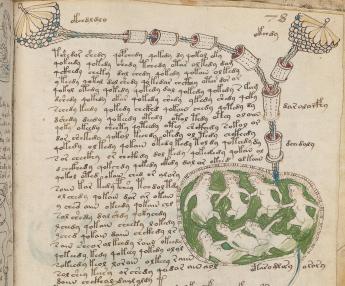Yale University Press - The Voynich Manuscript

In February 2014, media reported a breakthrough that had been made in attempts to decipher a mysterious 600-year-old manuscript written in an unknown language: The Voynich Manuscript, carbon-dated to the 1400s, was rediscovered in 1912, when the antiquarian bookseller Wilfrid Voynich bought it in Italy as part of a rare book collection. Since then it has defied codebreakers and scientists. The BBC and several news channels reported on the case.
Yale University Press has now published the "first authorized copy of this mysterious, much-speculated-upon, one-of-a-kind, centuries-old puzzle." (Yale)
But what was actually deciphered? Where have over 100 years of research led us?
Quoting from a recent review in the New York Review of Books:
"...if we can be fairly sure that the manuscript is not a modern forgery, it by no means follows that it is not in fact a medieval hoax. Four centuries of attempts to decode, decipher, or translate the text have all ended in bafflement. The finest cryptological minds of the twentieth century and sustained computer analysis alike have drawn a blank; the text refuses to yield meaning. Attempts to find parallels to the text in cabbalistical, hermetic, or alchemical code systems have all thrown up more disparities than resemblances. What if the book’s mysteries are in fact pure mystification, specious appearance that never had any real meaning?
This is a possibility strongly suggested by the manuscript’s single largest component, the herbal, with its crudely colored images of plants. No student of the herbal illustrations has ever succeeded in identifying convincingly a single image as any known plant. Medieval herbals were rarely based on exact observation from nature, but even by the conventions of medieval botanical representation, the Voynich images are, collectively and singly, biological impossibilities....
...In other words, the “plants” represented in the book’s herbal section never did and never could exist in nature: they are pure fantasy. And if the images are, then possibly the text is too. Even an uninformed observer examining any random pages of Beinecke MS 408 will be struck by the highly repetitious character of the text, with the same symbols and clusters of “letters” occurring in consecutive words and lines. This is a feature of the Voynich manuscript that has often been noted. It is one of the reasons for suspecting that the text is not in fact a real language at all, cunningly concealed, but an elegantly scripted but meaningless babble, deploying a limited number of forms over and over again.
Why might such a hoax have been perpetrated? The sheer scale, expense, and complexity of the Voynich manuscript would seem to preclude the notion that it was assembled as some kind of joke: it’s hard to imagine a punch line that required so elaborate a buildup. That leaves lunacy or lucre as possible motives. Madness can’t entirely be ruled out: mania takes many forms, and a well-to-do obsessive convinced he (or she) held the key to great secrets might drive the production of such a compilation.
But the likeliest motive surely must be money. The modern history of the Voynich manuscript, and the huge investment of time and effort by some of the most ingenious intelligences of the twentieth century in its decipherment, amply testify to human fascination with the possibility of uncovering secret knowledge. Back in the sixteenth century Rudolf II paid some persuasive soul six hundred gold ducats for Beinecke MS 408. It may well be that somewhere in early-fifteenth-century Europe another wealthy seeker after hidden truths was swindled by an equally enterprising purveyor of plausible nonsense. We shall probably never know. But maybe from the pages of Voynich’s “ugly duckling,” a long quack of derisive laughter peals down the centuries."
We recommend to read the full review of the book in the New York Review of Books here.
Read the ILAB article on the Voynich manuscript and attempts to decipher the 600 yr old manuscript, here.
The facsimilie edition can be bought through Yale University Press.
From the publisher's description:
Many call the fifteenth-century codex, commonly known as the “Voynich Manuscript,” the world’s most mysterious book. Written in an unknown script by an unknown author, the manuscript has no clearer purpose now than when it was rediscovered in 1912 by rare books dealer Wilfrid Voynich. The manuscript appears and disappears throughout history, from the library of the Holy Roman Emperor Rudolf II to a secret sale of books in 1903 by the Society of Jesus in Rome. The book’s language has eluded decipherment, and its elaborate illustrations remain as baffling as they are beautiful. For the first time, this facsimile, complete with elaborate folding sections, allows readers to explore this enigma in all its stunning detail, from its one-of-a-kind “Voynichese” text to its illustrations of otherworldly plants, unfamiliar constellations, and naked women swimming though fantastical tubes and green baths.
The essays that accompany the manuscript explain what we have learned about this work—from alchemical, cryptographic, forensic, and historical perspectives—but they provide few definitive answers. Instead, as New York Times best-selling author Deborah Harkness says in her introduction, the book “invites the reader to join us at the heart of the mystery.”
